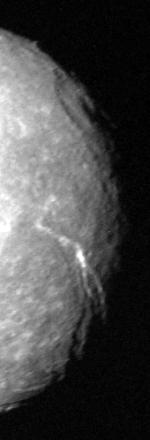Titania (moon)
Titania is the largest moon of Uranus and the eighth largest moon in the Solar System. Discovered by William Herschel on January 11, 1787, Titania is named after a character in Shakespeare's play A Midsummer Night's Dream. It orbits Uranus at a distance of about 436,300 kilometers (271,000 miles), making it the planet's farthest major moon.
Discovery and Naming[edit | edit source]
Titania was discovered on the same day as Oberon, Uranus's second-largest moon. The names of all four then-known moons of Uranus were suggested by Herschel's son, John Herschel, in 1852, at the request of William Lassell, who had discovered Ariel and Umbriel two years earlier. The names are derived from characters in the works of Shakespeare and Alexander Pope.
Physical Characteristics[edit | edit source]
Titania is an ice moon, with a surface composed of roughly equal parts ice and rock. Its surface is characterized by large craters, deep valleys, and long, steep canyons. One of the most notable features is a large canyon named Messina Chasma, which is over 1500 kilometers long and significantly impacts the moon's geology.
The moon's icy surface is believed to cover a subsurface ocean, similar to other outer Solar System bodies. However, the exact composition beneath the ice remains a subject of research. Titania's atmosphere, if it exists, is extremely tenuous and composed mainly of oxygen.
Orbit and Rotation[edit | edit source]
Titania orbits Uranus at a distance that makes it subject to significant tidal forces. These forces contribute to the moon's geological activity, including the formation of its canyons and valleys. Titania's orbit lies inside Uranus's magnetosphere most of the time, which protects it from the solar wind but exposes it to the planet's magnetic field.
The moon is tidally locked with Uranus, meaning the same side always faces the planet. This results in one hemisphere experiencing constant daylight and the other constant darkness, depending on the position in its orbit.
Exploration[edit | edit source]
To date, the most significant source of information about Titania comes from the Voyager 2 flyby in 1986. Voyager 2 provided detailed images of the moon's surface, allowing scientists to map its craters, canyons, and other geological features. However, no dedicated missions to study Titania or the Uranian system have been launched since.
Future missions to the Uranian system have been proposed, including orbiters and possibly landers. These missions would provide more detailed information about Titania's geology, atmosphere, and potential subsurface ocean.
See Also[edit | edit source]
Search WikiMD
Ad.Tired of being Overweight? Try W8MD's physician weight loss program.
Semaglutide (Ozempic / Wegovy and Tirzepatide (Mounjaro / Zepbound) available.
Advertise on WikiMD
|
WikiMD's Wellness Encyclopedia |
| Let Food Be Thy Medicine Medicine Thy Food - Hippocrates |
Translate this page: - East Asian
中文,
日本,
한국어,
South Asian
हिन्दी,
தமிழ்,
తెలుగు,
Urdu,
ಕನ್ನಡ,
Southeast Asian
Indonesian,
Vietnamese,
Thai,
မြန်မာဘာသာ,
বাংলা
European
español,
Deutsch,
français,
Greek,
português do Brasil,
polski,
română,
русский,
Nederlands,
norsk,
svenska,
suomi,
Italian
Middle Eastern & African
عربى,
Turkish,
Persian,
Hebrew,
Afrikaans,
isiZulu,
Kiswahili,
Other
Bulgarian,
Hungarian,
Czech,
Swedish,
മലയാളം,
मराठी,
ਪੰਜਾਬੀ,
ગુજરાતી,
Portuguese,
Ukrainian
Medical Disclaimer: WikiMD is not a substitute for professional medical advice. The information on WikiMD is provided as an information resource only, may be incorrect, outdated or misleading, and is not to be used or relied on for any diagnostic or treatment purposes. Please consult your health care provider before making any healthcare decisions or for guidance about a specific medical condition. WikiMD expressly disclaims responsibility, and shall have no liability, for any damages, loss, injury, or liability whatsoever suffered as a result of your reliance on the information contained in this site. By visiting this site you agree to the foregoing terms and conditions, which may from time to time be changed or supplemented by WikiMD. If you do not agree to the foregoing terms and conditions, you should not enter or use this site. See full disclaimer.
Credits:Most images are courtesy of Wikimedia commons, and templates, categories Wikipedia, licensed under CC BY SA or similar.
Contributors: Prab R. Tumpati, MD




